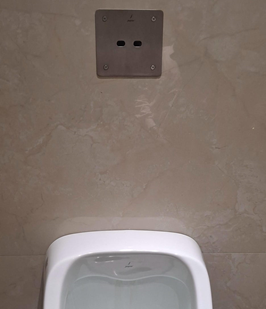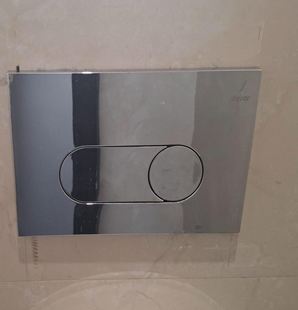
6.3.4 Water- Conscious Building Standards
Teerthanker Mahaveer University (TMU), Moradabad, stands at the forefront of sustainable campus development with the adoption of rigorous water conscious building standards implemented across its facilities. All new structures, renovations, and campus utilities are designed to minimize water consumption, reflecting the University’s commitment to resource conservation and global sustainability benchmarks.
Key water saving strategies include a rainwater harvesting system. The campus features dedicated water tanks to optimize Fly Ash Bricks at Construction collection, storage, and redistribution for domestic use, fire safety, and green space irrigation, regulated by a specialized maintenance team.
TMU’s buildings are constructed with water-efficient fixtures, Dual Flush Toilets, Low-Flow Taps, Fly Ash Bricks and Smart Urinals, Landscaping, and RCC roads designed for efficient runoff management, maximizing water retention and minimizing wastage.
Key Initiatives of Water-Conscious Building Standards
Overview
Teerthanker Mahaveer University (TMU), Moradabad, has adopted Water-Conscious Building Standards to ensure every new and existing structure on campus embodies principles of water efficiency, reuse, and sustainability. Through eco-engineering, smart plumbing systems, and sustainable architectural design, TMU minimizes water consumption across academic blocks, hostels, hospitals, and administrative buildings, directly contributing to SDG 6.3.4 — Preventing Water Waste through Sustainable Infrastructure.
Key Initiatives for Water-Conscious Building Standards
| Initiative | Implementation at TMU | Impact / Outcome |
|---|---|---|
| Low-Flow Fixtures and Dual-Flush Systems | All restrooms equipped with aerators, low-flow taps, and dual-flush toilets. | Reduction in indoor water use. |
| Rainwater Harvesting Structures | Every major building is integrated with rooftop collection pipelines and recharge pits. | Annual recharge of water. |
| Greywater Segregation System | Greywater from wash basins and hostels is redirected to STP. | Enables reuse in landscaping and flushing. |
💬 “Every brick at TMU is designed to save water — from the roof to the roots.”
Sustainable Design and Construction Features
| Feature | Purpose | Sustainability Benefit |
|---|---|---|
| Porous Paving and Permeable Surfaces | Facilitates rainwater infiltration. | Groundwater recharge and reduced runoff. |
| Green Roofs and Courtyards | Vegetated roofs reduce heat and absorb rainwater. | Lower surface runoff and ambient temperature. |
| Use of Recycled Building Materials | Incorporation of fly-ash bricks and eco-cement. | Reduces embodied water footprint. |
| Orientation and Daylighting Design | Maximizes natural lighting and ventilation. | Decreases cooling water needs. |
Institutional and Environmental Impact
| Impact Area | Observed Outcome |
|---|---|
| Reduced Groundwater Extraction | Reduction due to STP and rainwater recharge systems. |
| Enhanced Storm-Water Utilization | Controlled runoff and flood-free campus design. |
| Energy–Water Nexus Efficiency | Cooling towers and HVAC systems optimized for reuse. |
| Climate-Resilient Infrastructure | Campus buildings maintain thermal comfort with reduced resource load. |
Commitment Statement
At Teerthanker Mahaveer University, sustainability is built into the blueprint. By embedding water-conscious design, reuse systems, and smart technologies into every building, TMU ensures that infrastructure growth does not come at the cost of natural resources. Each structure stands as a symbol of responsible engineering and environmental stewardship, advancing the university’s pledge toward SDG 6 and SDG 13.
Overview
Teerthanker Mahaveer University (TMU), Moradabad, has achieved significant impact through the adoption of Water-Conscious Building Standards — integrating sustainable design, efficient plumbing, and reuse mechanisms across its entire campus infrastructure. These measures have led to measurable reductions in water consumption, optimized resource management, and long-term environmental benefits, advancing TMU’s commitment to SDG 6 (Clean Water and Sanitation) and SDG 13 (Climate Action).
Institutional and Infrastructural Impact
| Domain | Impact Description |
|---|---|
| Infrastructure Modernization | Retrofitting of older buildings with dual-flush systems, aerators, and sensor taps. |
| Operational Efficiency | Digital maintenance system ensures timely leak repair and fixture replacement. |
| Policy Compliance | Full adherence to water and building standards. |
Sustainability and Climate Impact
| Aspect | Result / Outcome |
|---|---|
| Reduced Carbon Footprint | Lower water pumping and treatment reduced emissions. |
| Thermal Comfort & Green Design | Passive cooling reduces temperature variation. |
| Eco-Conscious Urban Planning | Promotes biodiversity and natural recharge within built spaces. |
| Sustainable Construction Model | Demonstrates scalable low-water building design for other institutions. |
Monitoring, Evaluation & Verification
• Audits conducted at TMU.
• Documentation: Data reported to concerned stakeholders.
Commitment Statement
At Teerthanker Mahaveer University, architecture is not just about space — it’s about sustainability. Pipes, fixtures, and rooftops embody TMU’s pledge to conserve water, protect natural resources, and design for the future. By adopting Water-Conscious Building Standards, TMU ensures that its infrastructure contributes positively to climate resilience, community well-being, and global sustainability goals.




